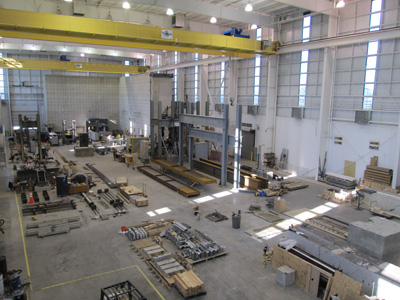Facilities
The 66,000 square-foot Robert L. and Terry L. Bowen Laboratory for Large-Scale Civil Engineering Research provides the space and technical capability needed to investigate the behavior of large structural models and elements subjected to loads representing extreme events, such as earthquakes, blasts, and impact, so that future structures will be designed to better withstand these extreme events. The lab's "strong floor," clear ceiling height of 54 feet, loading apparatus, and advanced instrumentation set a new standard for materials and structures testing.

Intelligent Infrastructure Systems Lab (IISL)
The IISL, housed within the Bowen Laboratory at Purdue, is dedicated to research and instruction in the dynamic responses of structural systems. Research activities in the lab focus on structural health monitoring, structural control, and real-time hybrid testing. Analytical and experimental activities are pursued in parallel. The main features of the laboratory include a small scale earthquake simulator and a novel real-time hybrid testing facility. Other equipment contained in the laboratory includes three instructional shake tables which can be operated remotely (see nees.org), a Krypton 6D tracking system, a dSpace real-time control system and extensive data acquisition and sensing capabilities.
Center for Structural Engineering & Emerging Technologies for Nuclear Power Plants
The SEET-NPP center leverages the large-scale testing facilities and expertise at Bowen Laboratory to provide for the experimental and analytical research needs of the nuclear power industry, utilities, and the Nuclear Regulatory Commission. Through the center, these interested parties have access to one of the largest structural engineering laboratories in the world, and the ability to evaluate the structural behavior, seismic performance, reserve margin, extreme event (accident) performance, material properties, and construction and inspection of large-scale structural systems for use in modern nuclear power plants. Equipment available includes numerous large-capacity, double acting hydraulic actuators and associated control systems, calibrated sensors, data acquisition systems, and radiant heaters for applying accident temperatures or fire temperature loading.
